Blaxploitation, Italian style
The stories of the Afro-Italian, African-American, and Afro-Caribbean actors and crews who helped shape Italy's film industry.

The Eritrean-Italian actress Zeudi Araya who appeared in number of Italian films in the 1970s.
Italian cinema is renowned the world over for its technical and artistic innovations, from the neorealism of De Sica and Rossellini to the surrealism of later Fellini, or the radical sexual explorations of Pasolini to the anti-colonialism of Pontecorvo. Consistent throughout this rich legacy of cinema however, but scarcely remarked upon, is the presence of black folk in both minor and major roles.
The stories of these actors, several uncredited in their early films, remained largely untold until the 2013 publication of film scholar Leonardo de Franceschi’s comprehensive, edited volume L’Africa in Italia: Per una controstoria postcoloniale del cinema italiano (Africa in Italy: A postcolonial counter-history of Italian cinema). This book, along with filmmaker Fred Kuwornu’s own experiences in the Italian film industry as both an actor and a director, inspired the documentary “Blaxploitalian: 100 Years of Blackness in Italian Cinema.”
Kuwornu’s documentary is equal parts individual narrative, detective film, film studies lesson, and call to action. It asks, who are (or were) these actors? What do their experiences, and the roles they played, say about race and national identity in Italy? And what can be done today to ensure that Italian cinema reflects the increasing diversity of Italian society?
Kuwornu is an Italian-Ghanaian filmmaker who was born and raised in Bologna; he now resides part-time in New York City. A student of political science, he was inspired to begin documentary filmmaking after acting and working as a set assistant for Spike Lee’s 2008 film “Miracle at St. Anna”, about African-American soldiers in Italy during World War II. He produced two acclaimed documentaries prior to “Blaxploitalian: Inside Buffalo,” about the African-American soldiers of the 92nd Infantry Division who served in Italy during World War II, and 18 Ius soli, about the children of immigrants born in Italy and their struggles for Italian citizenship. [Full disclosure: I have known Fred since 2013, and assisted with the translations for Blaxploitalian.]
Blaxploitalian explores the stories of Afro-Italian, African-American, and Afro-Caribbean actors whose roles helped to shape the Italian film industry. Beginning in 1915, when the first black actor appeared in an Italian film, the documentary’s “one hundred years of blackness” spans Eritrean actors who arrived to Italy after the dissolution of the Italian Empire and African-Americans who found greater opportunity in the Italian film industry than in the United States (the documentary even shows a jaunty 1954 article from Jet Magazine entitled “Italy’s Movie Boom for Negro Actors”). Kuwornu manages to track down and interview many of these actors, including Denny Méndez, the now Los Angeles-based Dominican-Italian actress and model who shocked the nation when she was crowned Miss Italy in 1996. These engrossing interviews are interspersed with conversations with Italian film scholars such as Ruth Ben-Ghiat and Leonardo de Franceschi about the multiple inflections of blackness in Italian cinema (the “exotic,” the “native who must be subjugated,” etc.) and the relationship between cinema, colonialism, and nation building.
Toward the end of “Blaxploitalian,” however, the tone of the documentary shifts. Kuwornu shows that Black folk in Italy are increasingly taking roles behind the camera; they are also pushing for more equitable (and less stereotypical) representation. Actor after actor in the documentary describes the humiliation of being asked to put on an exaggerated “African” accent for a role, or only being called to audition for the part of the nanny/prostitute/terrorist/undocumented migrant.
One actor in particular recounts the mind-bending story of auditioning for the role of a southern Italian, and then being told that he looks more North African – but later, when he comes in to audition for the role of a North African, he is told that he looks too southern Italian. For every Black actor who is told that he is too “African” to play the part of an Italian, another is told that she is too “Italian” in her mannerisms to play a character of African descent.
Fortunately, this double-bind is slowly beginning to give way as Afro-Italian actors gain momentum in their advocacy for roles that reflect the “everyday multiculturalism” of Italian society. Igiaba Scego, for instance, describes the significance of Ethiopian-Italian actress Tezeta Abraham’s role in the television series “E’ arrivata la felicità”:
Tezetà plays the role of Francesca, a woman who works in a children’s bookstore, and is not too lucky with men. A sort of Black Bridget Jones, with multicolored sweaters that would make the real Bridget jealous… Furthermore, her Roman accent, combined with her rough voice, “rocks,” as the young people might say. It rocks indeed, symbolically linking her to the tradition of the best Italian films, in which Cinecitta’ studios were transformed into city outskirts, into narrative, into life… Tezetà’s Francesca is important for another reason: she is a mirror for many Afro-Italian girls who work, study, and love in this Italy, which is more and more mixed even if it doesn’t see itself that way. Italy tells very little, especially on TV, about the changes it has undergone since the 1970s.
Fred Kuwornu has asserted elsewhere that new media tools such as crowdfunding and social media, along with the increasing accessibility of digital media filmmaking tools, have also contributed to this growing pluralism, since it has become easier and more affordable for people to tell their own stories (instead of waiting for major media outlets to take notice).
“Blaxploitalian” is part of a broader media diversity campaign entitled “United Artists of Italy,” which Kuwornu has spearheaded along with several other Italian creatives. In addition to this project, activists in Italy have recently advocated for less stereotypical depictions of the African continent, and for laws that would require more equitable representation on television. These campaigns have brought national attention to the pervasive sexism and racism in Italian media –from the use of blackface in a video published by the website of the national newspaper La Repubblica, to the racially-charged imagery of laundry detergent commercials (as documented by Cristina Lombardi-Diop), to a recent segment on the national RaiUno television channel about the benefits of “choosing a girlfriend from the East.”
Of course, media diversity is not just an Italian issue; the work of Kuwornu and his colleagues is inspired by and interwoven with similar initiatives elsewhere: #OscarsSoWhite in the United States, as well as the work of Idris Elba in the UK and Omar Sy in France. But one could argue that there is a particular exigency to the situation in Italy, in which the ongoing refugee “crisis,” the obstruction of a legislative proposal to grant citizenship to the children of immigrants, the rise of the far-right, and economic stagnation have conspired to produce an especially virulent brew of anti-Black racism all’italiana. In this context, “Blaxploitalian” implicitly argues, representation matters.



















